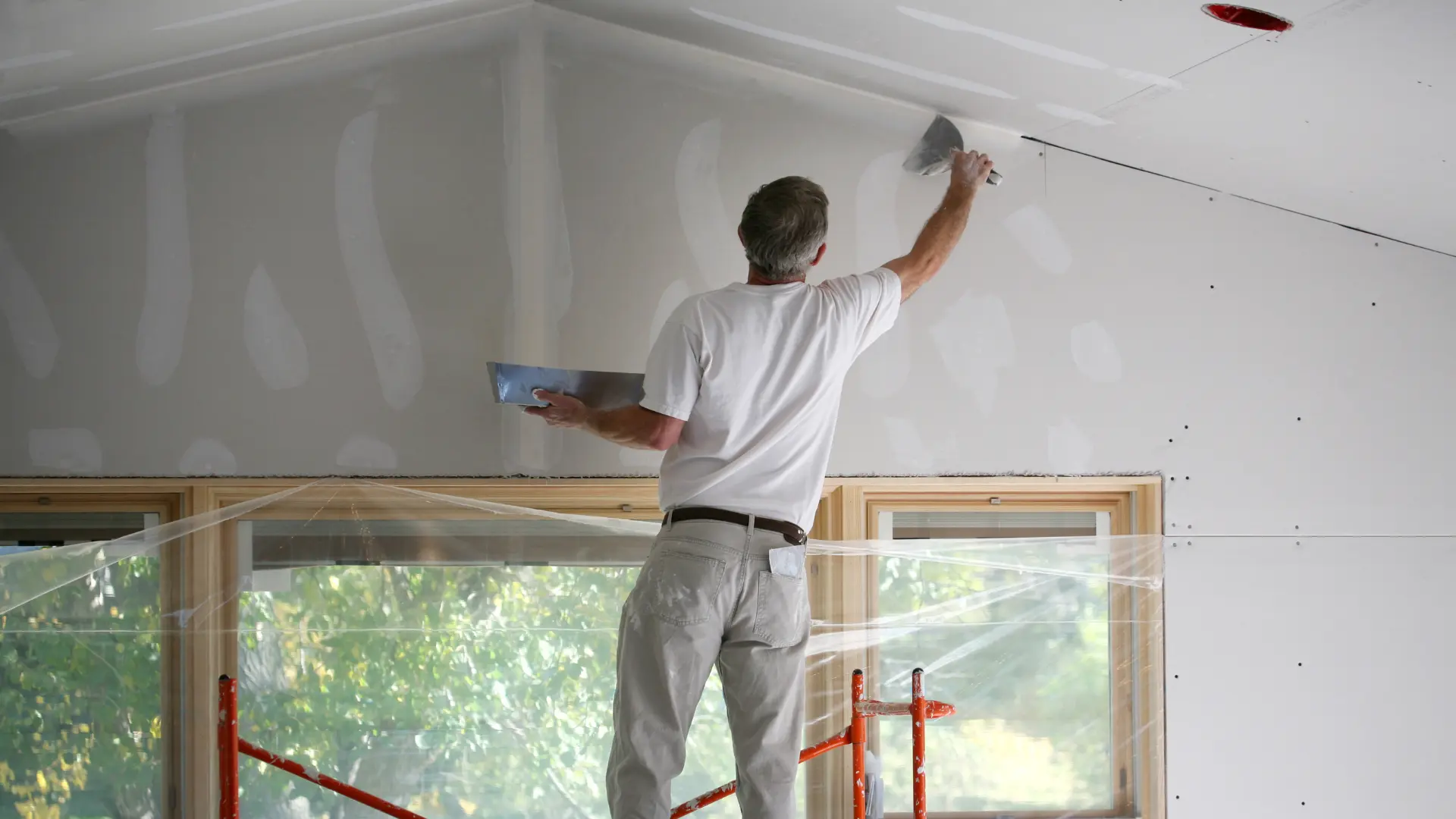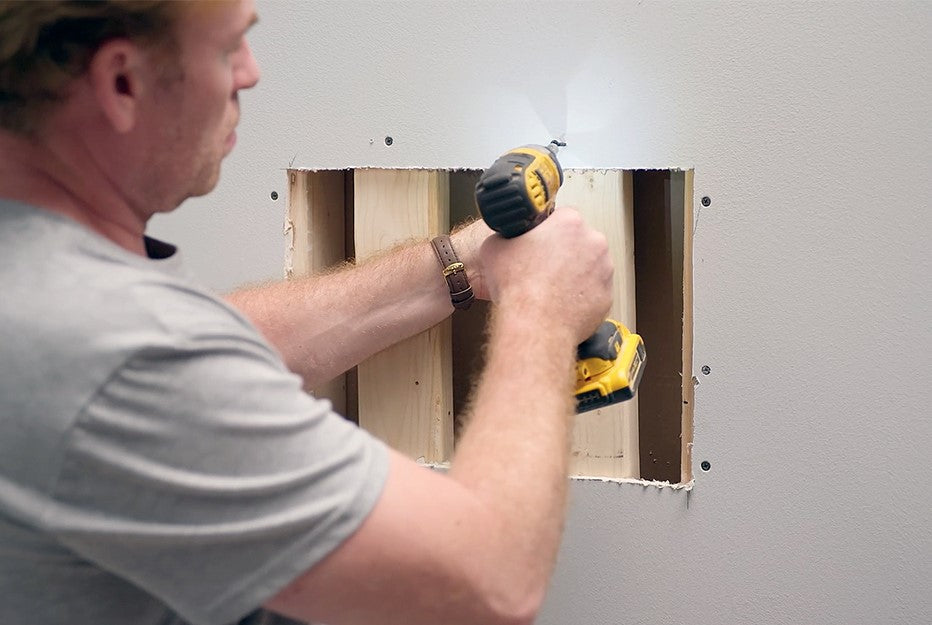Step-by-Step Approaches to Getting Flawless Drywall Repair Service and Setup
Achieving perfect drywall repair work and setup requires a systematic approach. It involves comprehending the various kinds of drywall and the tools required for the task. Proper area prep work is essential before beginning any type of job. drywall contractor. Each action, from patching holes to setting up brand-new sheets, needs attention to information. The process doesn't end with installment; finishing strategies are vital for a sleek appearance. The next actions will guarantee a smooth outcome, however exactly what do they involve?
Understanding Drywall Kind and Equipment Needed

The setup tools are similarly vital. An utility knife is crucial for reducing drywall sheets, while a drywall saw can aid in making specific cuts for outlets or fixtures. T-squares assure exact dimensions, and drywall screws or nails safeguard the panels to wall surface studs. Additionally, a drywall lift can assist in the installment of big sheets, minimizing physical stress. Familiarity with these tools and types considerably adds to the effectiveness and quality of drywall jobs.
Preparing the Location for Fixing or Installment
Preparing the location for drywall repair or installment is crucial to ensure a smooth and reliable procedure. The surrounding area needs to be cleared of furniture and other challenges to give sufficient working space. This not just ensures safety but also avoids damages to possessions. Next, it is necessary to cover the flooring with ground cloth to capture any particles or dirt created throughout the job.
In addition, the wall surfaces must be evaluated for any kind of loosened paint or wallpaper that might hinder adhesion. Removing these aspects produces a tidy surface for the new drywall. Prior to start, it is advisable to transform off power to electrical outlets or fixtures around. Ensuring appropriate lights in the workspace will certainly additionally enhance visibility and focus during the repair service or setup procedure. Drywall Repair Ogden UT. By thoroughly preparing the location, one lays the groundwork for a successful drywall project
Step-by-Step Refine for Patching Holes

Patching openings in drywall calls for a systematic strategy to assure a smooth repair. The primary step entails evaluating the size of the hole. For tiny holes, a patching compound might suffice, while bigger holes require a patch. Next off, the damaged location ought to be cleansed and prepared by eliminating any type of loosened debris.
For tiny holes, using spackling substance with a putty knife is recommended, smoothing it over the hole and feathering the sides. As soon as completely dry, fining sand the area guarantees a smooth surface. For larger holes, a drywall spot should be cut to dimension, placed over the opening, and safeguarded with screws. After installing the spot, the same spackling procedure is duplicated, adhered to by fining sand.
The patched area must be topped and repainted to match the surrounding wall surface. This precise procedure ensures a professional look and extends the lifespan of the fixing.
Installing New Drywall Sheets: A Comprehensive Guide
Installing brand-new drywall sheets requires careful planning and implementation to ensure a tough and aesthetically appealing coating. The location has to be gauged precisely to determine the number of sheets needed. It is crucial to select the ideal thickness, typically 1/2-inch for interior walls and 5/8-inch for ceilings or fire-rated applications.
Next off, the studs or framework must be checked for any abnormalities, seeing to it they are aligned and appropriately spaced. When placing the drywall sheets, they must be placed flat to minimize seams and boost structural integrity. A drywall lift can be valuable for overhead setups.
Securing the sheets with drywall screws at ideal periods makes certain a protected installment. It is very important to countersink the screws somewhat below the surface area to prepare for the ending up process. Following these standards will certainly bring about a strong structure, all set for the next action in drywall ending up.
Completing Touches: Insulation, Mudding, and Sanding Techniques
When the drywall sheets are firmly secured, the focus moves to the finishing touches that will provide a refined look. This procedure begins with taping, making use of either paper or fiberglass harmonize tape to cover the seams in between sheets. The tape ensures a smooth change, reducing the threat of cracking. Complying with insulation, mudding is important; a joint compound is used over the tape to load voids and develop a seamless surface. Commonly, several layers are needed, each one feathery out further than the before minimize exposure.
After enough drying time, sanding is the last action in accomplishing a perfect finish. A fine-grit sandpaper is made use of to smooth the dried compound, guaranteeing there are no bumps or flaws. Interest to detail throughout this stage is considerable, as it substantially impacts the general appearance of the wall surface. The end outcome ought to be an even, professional-looking surface all set for priming and paint.
Regularly Asked Inquiries
How Do I Select the Right Drywall Density for My Project?
To pick the right drywall density, consider the project's purpose, place, and architectural needs. Criterion densities include 1/2-inch for general usage and 5/8-inch for fire-rated applications, making sure longevity and conformity with building regulations.

Can I Mount Drywall Over Existing Drywall?
Yes, setting up drywall over existing drywall is feasible. It is vital to assure the underlying surface is totally free and safe and secure from damage. Correct attachment and factor to consider of thickness are vital for an effective setup.
What Are the Best Practices for Drywall Disposal?
The very best practices for drywall disposal consist of recycling when feasible, utilizing local waste monitoring services, and following guidelines for hazardous materials if suitable. Drywall Installation Ogden Utah. Properly sealing and labeling waste guarantees conformity and safety and security throughout disposal
For how long Should I Wait On Mud to Dry Before Fining sand?
Generally, one must wait 24 hr for drywall mud to completely dry prior to sanding. Drying out time can vary based on humidity and temperature, so inspecting for a firm appearance is recommended prior to continuing.
Are There Eco-Friendly Drywall Options Available?
Yes, environment-friendly drywall alternatives are readily available. These alternatives frequently make use of recycled products, low-VOC adhesives, and sustainable production approaches, minimizing ecological effect while supplying effective insulation and longevity for different building and improvement jobs.
An utility blade is important for reducing drywall sheets, while a drywall saw can assist in making precise cuts for fixtures or electrical outlets. Preparing the area for drywall repair or installation is crucial to assure a efficient and smooth process. Covering openings in drywall needs a systematic technique to assure a smooth repair. Mounting new drywall sheets requires mindful preparation and execution to ensure a strong get more info and aesthetically enticing surface. Yes, setting up drywall over existing drywall is feasible.